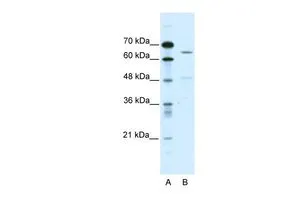
WB analysis of HepG2 cells using GTX47700 ACCN1 antibody at 0.2-1microg/ml. Lane A : marker Lane B : HepG2 cells
ACCN1 antibody, C-term
GTX47700
Overview
- SupplierGeneTex
- Product NameACCN1 antibody, C-term
- Delivery Days Customer9
- Application Supplier NoteWB: 0.2-2.5 ug/ml. *Optimal dilutions/concentrations should be determined by the researcher.Not tested in other applications.
- ApplicationsWestern Blot
- CertificationResearch Use Only
- ClonalityPolyclonal
- Concentration0.5-1 mg/ml
- ConjugateUnconjugated
- Gene ID40
- Target nameASIC2
- Target descriptionacid sensing ion channel subunit 2
- Target synonymsACCN; ACCN1; acid sensing (proton gated) ion channel 2; acid-sensing ion channel 2; amiloride-sensitive cation channel 1, neuronal; ASIC2a; BNaC1; BNC1; brain sodium channel 1; hBNaC1; mammalian degenerin homolog; MDEG; neuronal amiloride-sensitive cation channel 1
- HostRabbit
- IsotypeIgG
- Protein IDQ16515
- Protein NameAcid-sensing ion channel 2
- Scientific DescriptionThis gene encodes a member of the degenerin/epithelial sodium channel (DEG/ENaC) superfamily. The members of this family are amiloride-sensitive sodium channels that contain intracellular N and C termini, 2 hydrophobic transmembrane regions, and a large extracellular loop, which has many cysteine residues with conserved spacing. The member encoded by this gene may play a role in neurotransmission. In addition, a heteromeric association between this member and acid-sensing (proton-gated) ion channel 3 has been observed to co-assemble into proton-gated channels sensitive to gadolinium. Alternative splicing has been observed at this locus and two variants, encoding distinct isoforms, have been identified. [provided by RefSeq, Feb 2012]
- ReactivityHuman
- Storage Instruction-20°C or -80°C,2°C to 8°C
- UNSPSC12352203
